Don't wanna be here? Send us removal request.
Photo
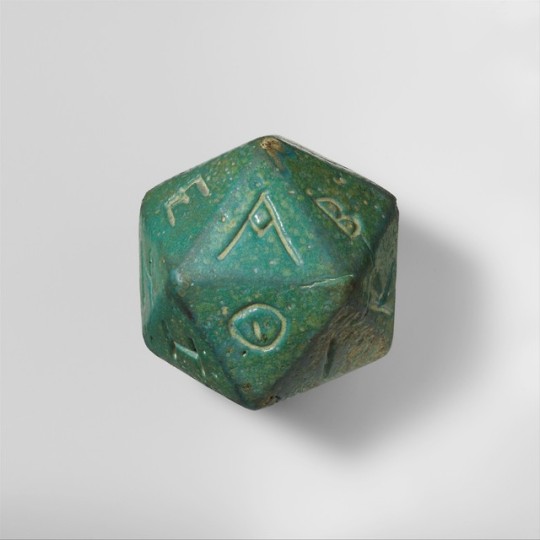
Roman, Faience polyhedral inscribed with Greek letters, 2nd-3rd century (source).
“A number of polyhedra of various materials are known from the Hellenistic and Roman periods. They may have been used in conjunction with an oracle inscribed on a pillar set up in a public place. The polyhedron was thrown in order to choose a letter at random. One consulted the inscription to find the matching letter and read the oracle’s response. There would be twenty oracular messages, each beginning with a letter of the alphabet that corresponded to one side of the dice.” - from the Met description
3K notes
·
View notes
Text
List of resources for dnd
roll20: Make an account to play the game
Orcpub: For hosting and editing your character sheet
DND Wiki: Homebrew things, races, classes, misc
Players Handbook: Rules how to play how to make a character, all basic information for playing a game
Discord: to talk during and about the game
91K notes
·
View notes
Text
op openly promotes and encourages being possessed by malevolent entities
2K notes
·
View notes
Text
Rations for various RPG Races
[[ Source. Original creator: wats6831. Additional information and images linked under each one. ]]
Universal:
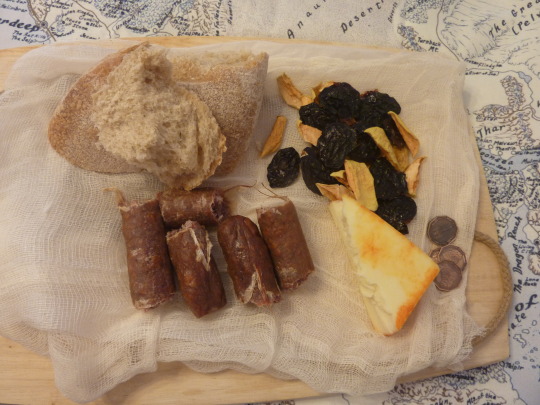
Homemade artisan herb bread, home grown and dried apples and prunes, uncured beef sausage, munster cheese. Made a small bag from cheesecloth and tied it closed.
Discussion thread here.
Dwarf:

Garlic chicken livers, smoked and peppered cheese, spiced pork sausages, hard tack, dried vegetables, dried wild mushrooms.
Discussion thread here.
Elf:

Top left to right: Evereskan Honey Comb, Elven Travel Bread (Amaretto Liquer Cake with custom swirls), Lurien Spring Cheese (goat cheese with garlic, salt, spices and shallots), Delimbyr Vale Smoked Silverfin (Salmon), Honey Spiced Lichen (Kale Chips), and Silverwood Pine Nuts.
Discussion thread here.
Halfling:
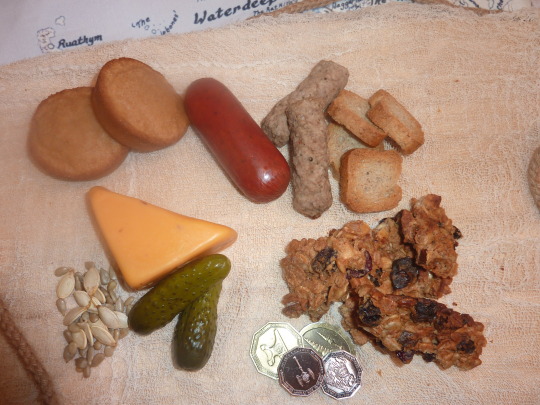
From upper left: “Honeytack” Hard tack honey cakes, beef sausage, pork sausage mini links, mini whole wheat toast, cranberry cheddar cheese mini wedge, mini pickles, pumpkin and sunflower seeds, lower right is my homemade “travel cake” muesli with raisins, golden prunes, honey, eggs and cream.
Discussion thread here.
Half-Orc:

Wrapped in cheesecloth and tied in burlap package. Forest strider drumsticks, molasses sweet wheat bread “black strap���, aged Munster, hard boiled eggs, mixed wild nuts.
Discussion thread here.
Orc:
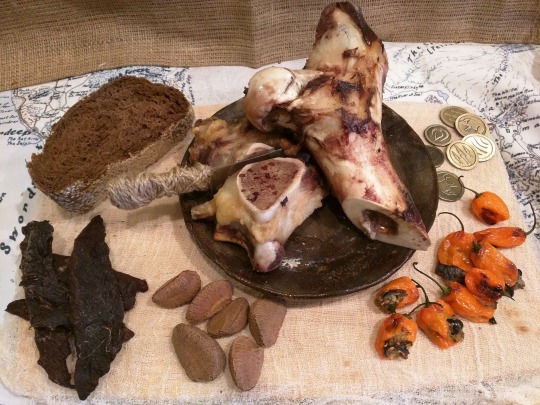
Orcs aren’t known for their great cuisine. Orcs prefer foods that are readily available (whatever can be had by raiding), and portable with little preparation, though they have a few racial delicacies. Toughs strips of lean meat, bones scavenged from recent kills, and dark coarse bread make up the bulk of common orc rations.Fire roasted rothe femur (marrow is a rare treat) [beef femur], Strips of dried meat (of unknown origin) [homemade goose jerky], foraged nuts, only edible by orcs….nut cracker tusks [brazil nuts], coarse black bread, made with whatever grains can be pillaged [black sesame bread], Pungent peppers [Habanero peppers stuffed with smoked fish and olives].
More images here. Discussion thread here.
Gnome:
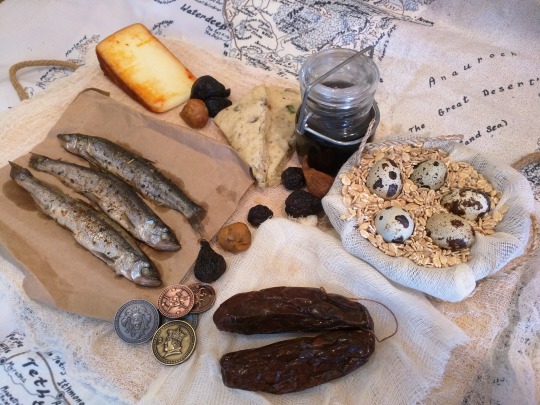
Pan fried Delimbyr smelt, spiced goat cheese (paprika crusted hand pressed Fontina), Gnome shortbread (savory pistachio), glass travel jar filled with Secomber Red (wine), hard boiled quail eggs packed in rolled oats (to keep safe), dried figs from Calimshan, and Southwood smoked goat sausage (blood sausage).
More images here. Discussion thread here.
Lizardfolk:

Lizardfolk are known to be omnivores, forage for a surprising variety of foods found within the confines of their marshy environs, in this case the Lizard Marsh near Daggerford. Fresh caught boiled Delimbyr Crayfish on wild chives, coastal carrageen moss entrapping estuary brine shrimp (irish moss, dried brine shrimp), Brackish-Berries (blackberries), Blackened Dart-Frog legs (frog legs) on spring sprouts (clover sprouts), roasted bog bugs on a stick!
More images here. Discussion thread here.
Drow:

From top left: Menzoberranzan black truffle rothe cheese (Black Knight Tilsit), Donigarten Moss Snails (Escargot in shallot butter sauce), Blind cave fish caviar in mushroom caps (Lumpfish caviar), faerzress infused duck egg imported from the surface Realms (Century egg), Black velvet ear fungus (Auricularia Black Fungus Mushroom).
More images here. Discussion thread here.
221K notes
·
View notes
Text
lesser known dice in dnd
2 sided die: flip a coin
1 sided die: im the dm and i said so
97K notes
·
View notes
Text
heleddi stormfist
race: half-orc half-dwarf alignment: lawful neutral [tending towards good] background: guild artisan class: barbarian
const: 17 (+2 racial) = 19, +4 bonus //// str 14 (+2 racial) = 16, +3 bonus dex: 13, +1 bonus /// wis: 13, +1 bonus int: 12, +1 bonus // char: 12, +1 bonus
speed: 30 feet max carry: 210 lbs
hit dice: 1d12 per level lvl 1 hp: 12 + const = 16 // hp per level: 1d12 or 7 + const (4)
ac: 10 + dex + const (class bonus) = 10+1+4 = 15 passive perception: 10 + 1 bonus + 2 proficiency = 13
personality
rolled / selected largely from the guild artisan tables and embellished:
personality trait: 1 and 3 and 5
i believe that anything worth doing is worth doing right. i can’t help it — i’m a perfectionist.
takes pride in her work, but tends to progress slowly and carefully. a firm believer in measure twice, cut once.
i always want to know how things work and what makes people tick.
observant; won’t attempt a new task or behavior until she’s seen it executed successfully enough times that she’s sure she understands how it works.
attentive to the emotional states of the people around her; wary and somewhat emotionally closed off herself.
i’m rude to people who lack my commitment to hard work and fair play.
somewhat judgemental. tends to assume the worst of other people’s motivations; especially so towards people she judges as motivated strongly by chaotic self-interest.
ideal: one and five and six
community. it is the duty of all civilized people to strengthen the bonds of community and the security of civilization. (lawful)
people. i’m committed to the people i care about, not to ideals. (neutral)
the above two: not necessarily the security of civilization, but the security of the places and people she considers hers.
aspiration. i work hard to be the best there is at my craft
to further her craft
but also to master and channel her emotional rages, so that she can go home and settle down with a nice dwarven boy
bond: one, secondarily three
the workshop mountain where i learned my trade is the most important place in the world to me.
i owe my guild a great debt for forging me into the person i am today.
character flaws: [not rolled]
paralyzing self-distrust, second-guessing
she does not trust her own judgement, her own emotions, and is concerned with how she appears to others. she has no desire to be intimidating, and she is frightened by her culturally proscribed emotionality.
wary and insecure.
she spends a lot of time watching others and attempting to fit in socially as she could not physically. this has made her unusually discerning of others’ emotions, but she isn’t always the most accurate at determining why people react the way they do. she has a tendency to assume the worst of others.
character and background
orcish name “elet” dwarficized to heleddi
grew up in a dwarvish metalworking community; she is the result of a an ill-conceived tryst between her dwarven father and orc mother. her mother reappeared in the mountains with a toddler a few years later, and left her behind. she barely remembers her time in the orc tribes, and may or may not have any mementos from her mother1; her command of orcish - once fluent - has lapsed over the years (reads/writes fluently, speaks without an accent and can pass among orcs without detection for simple sentences; complex conversations require a saving throw to determine whether she fucked up a grammar).
she grew up in lawful good dwarvish society, very aware of her status as an outsider both by appearance and temperament. her branch of the clan was seen as unusually modern, her father was already considered impulsively experimental even before her birth. hyperaware of the fact that her existence caused a tremendous scandal and badly damaged her father’s reputation, she isolated herself from her peers in early childhood, and no one tried hard to stop her (aughts). she was kept away from combat training for much of her adolescence2 (teens) due to fears that her increased size and strength, emotional volatility, and orc blood might make her a danger to herself or others.
she spent much of her time watching others and attempting to pattern herself after dwarvish behavior, but still found herself wracked by worryingly strong emotional whirlwinds: tantrums and rages, bouts of sobs or laughter so intense her body was wracked with them, immobile, while they siezed her. most of her emotions were fleeting as summer storms, disturbing the steady and slow-moving dwarves around her. worse, her emotional disturbances sometimes stuck with the same powerful certitude that defined a typical dwarven emotional range, but with depths and peaks rarely reached by dwarves outside of isolated moments. her rage wasn’t the slow simmer of a dwarven grudge, but a shrieking boil that would refuse to abate; her worry would sink into her bones, leaving her sorrowful and weeping for weeks at a time before the next emotion hit.
eventually, she learned to focus her emotionality through her metalwork, to find some regulation of her excesses. here she finally found connection: her increased strength and passionate emotional range caused her to struggle with inconsistent craftwork her dwarven peers did not face, but her willingness to redo her work until it was perfect, her struggle to ensure that she would make a perfect piece on the first try no matter how gripped she was by emotion: this struggle and her deep, stubbornly-held dedication to this craft helped other dwarves relate to her and resulted in artistic and technical discussions that were the seed of her first true and lasting friendships. (twenties)
**figure out her eventual weapons training - she’s proficient with light hammers and hand-axes just because... you’re dwarf-raised you learn how to use them, but possibly not AS proficient using them in combat (doesn’t have practice hitting a Moving Bleeding Target with them). her actual weapons are likely to be larger/heavier than typical dwarvish warhammer/battleaxe - ideally greataxe & maul3
[[something happens that brings out her Rage in combat - possibly a sparring accident in which she injures or kills someone close to her, possibly acting in defense of her friends but terrified with the violence with which she lashed out.]]
either way, it both frightened her enough to cause her to remove herself from the community which she had been raised to value above all else, in order to learn to master - or at the very least channel - her rage, until she feels she can safely return home.
1 - at dm’s discretion, possibility of backstory for future plot, etc. 2 - possibly trade some forms of proficiency for others - she’s late to the game and somewhat banking on natural talent but also likely to use heavier/larger weapons 3 - at dm’s discretion but holy shit PLEASE
skills & proficiencies
species: half-dwarf, socialized dwarf (no orcish skill proficiencies beyond the language itself)
languages: dwarvish (primary), common (accented secondary), orcish (tertiary semifluent; roll a deception during involved speech).
see background for additional language skill (gnomish)
resilience: resistance to poison; 1/2 poison damage
stonecunning: advantage in history (int) throws => history of stonework; add double the normal proficiency bonus to the roll
tool proficiency: smithing
combat training: proficiency in battleaxe1, warhammer1, hand-axe, light/throwing hammer
mountain dwarf armor training: proficient with light and medium armor
1 - again, trade for greataxe / maul proficiency at the dm’s discretion
class: assumes a Barbarian Tribe training background not relevant 2 her.
proficient with light and medium armor
proficient with use of shields
proficient with simple and martial weapons
skilled in (choose two): animal handling, athletics, intimidation, nature, perception, survival
all of these overlap with dwarven proficiencies with the exception of shield usage, which i’m not sure i can justify her taking given that she probably largely relies on two-handed weapons.
also, given that she’s fairly sheltered with very little real-life battle experience the only skills i’d feel make sense would be perception (people-watching! she’s an observer!) and maybe athletics.
her barbarian classing is like an innate characteristic of how she fights, not representative of her character background or training.
background: guild artisan
skill proficiencies: insight, persuasion
she’s probably got insight from Peoplewatching but maybe not persuasion? poorly socialized? half a proficiency bonus?
tool proficiencies: one type of artisan’s tools
smith’s tools (overlaps with dwarven training)
languages: one of your choice
limited conversational and written fluency in gnomish - enough for trade, but possibly not to discuss philosophy.
feature: guild membership. guaranteed food/lodging from members; funeral paid for; guild halls to make connections (jobs!). political connections. will help you @ trial.
cost: 5gp per month in dues to remain in good standing
equipment
barbarian starts with:
(a) a greataxe or (b) any martial melee weapon
ideally a maul (10lb/2hand/2d6 bludgeoning)
failing that a greataxe (7lb/2hand/1d12 slash)
(a) two handaxes or (b) any simple weapon
handaxe (light, thrown 20/60, 2lb/1d6 slash) 4lb total
an explorer’s pack (59lbs)
backpack, a bedroll, a mess kit, a tinderbox, 10 torches, 10 days of rations, a waterskin, and 50 feet of hempen rope.
four javelins
trade javelins for light hammers?
light hammer: (light, thrown 20/60, 2lb/1d4 bludgeon)
guild artisan starts with:
a set of artisan’s tools (one of your choice)
weaponsmith’s tools: 20gp / 8lb
a letter of introduction from your guild
a set of traveler’s clothes
a belt pouch containing 15 gp
trinket:
roll closer to play
math for ability scores:
2 5 5 1 = 12 5 2 3 4 = 12 3 1 6 4 = 13 6 3 4 2 = 13 2 5 4 5 = 14 4 6 5 6 = 17
5 notes
·
View notes
Text
my favorite thing about dungeons and dragons is that you can study for it alone, wherever you are, and also the fact that i found an entire database of free resources about 5.0 that are basically all you need to play except for an actual campaign lol
98K notes
·
View notes
Photo



My girlfriend made these amazing hand-drawn class-specific character sheets that can be used to play 5th Edition. All 12 base classes are represented and they’re all customized to have everything you need to play that’s not found on the basic character sheets. Printable & PDF form fillable! A great pickup, check ‘em out: > More pictures. > Shop & Specific sheet details.
27K notes
·
View notes
Photo



Hey guys! I am so unbelievably happy to announce that my secret project is officially finished! After four solid months of work, Table Fables is complete.
Now, Table Fables is a labor of love - 84 illustrated pages of item tables and generators to make dungeon masters’ lives a little easier. Inside you’ll find a ton of cool things including but not limited to: a full character generator, a disease generator, a kingdom generator, potion generator, a magic items table, a scavenging table, a curse table, a dream table and a ton of other little fun things!
If you want to check it out on Amazon, click here! It’s a super cheap, fun little book meant to make DnD a little more interesting. Thanks for reading!
10K notes
·
View notes
Photo
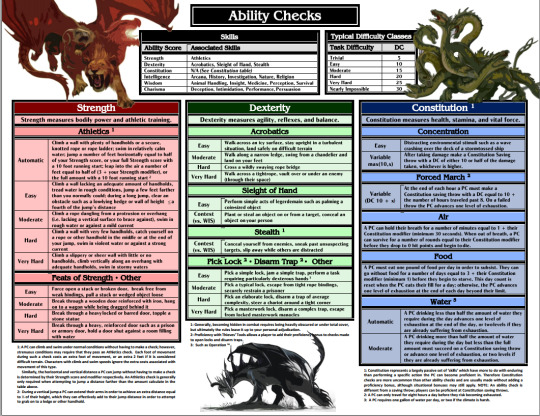
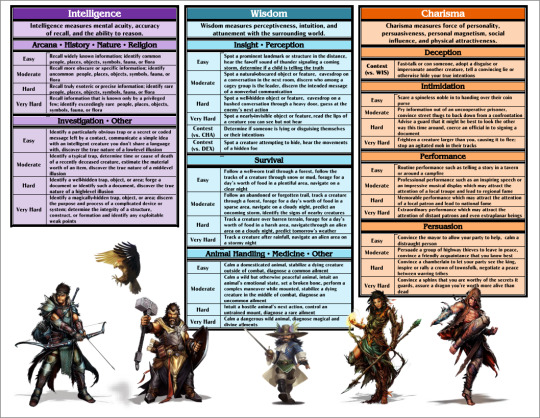

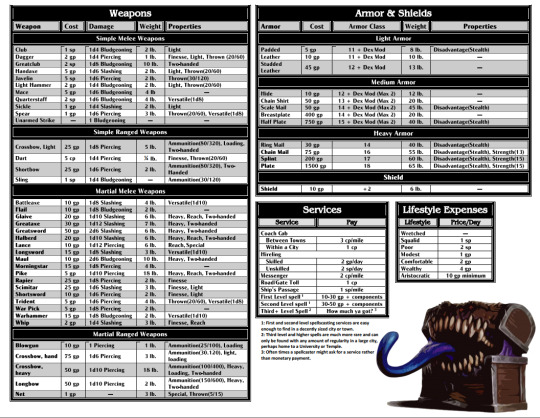
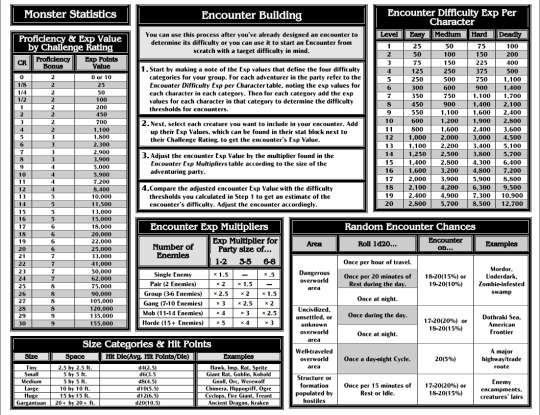
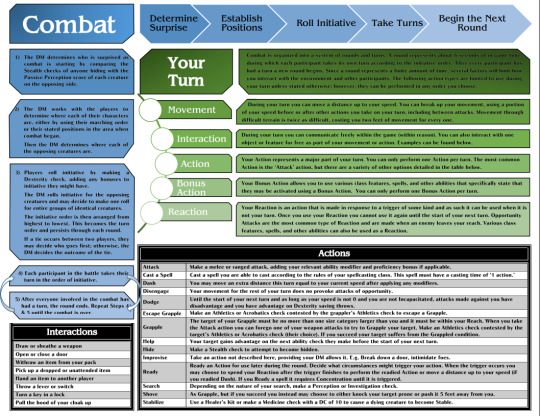
To the person who put this together, BLESS YOU
41K notes
·
View notes
Photo

Dungeon Master Apps
Dragon + is great for updates to current content, it is a endless well of information that should spark anyone’s creativity. It’s all around a great publication.
Fantasy is awesome for atmosphere and an alternative to the YouTube which plays adds, or constantly has you searching for a new song to play.
Trello connects to both your phone and computer and is a great alternative to physical note cards. My favorite for session prep.
Story Cubes always pull me out of writers block. Some of my favorite game moments came from a random roll of these die.
Time Tree my least favorite side of D&D is organizing the best time for everyone to play. This app allows all the players to upload their schedules and makes life so much easier.
Can anyone recommend any other apps that make DMing easier and more fun?
20K notes
·
View notes
Text
@centralkvetchmonolith
From the last section, all but the first from dwarf are social so I'd say take all of those and then choose one of {dwarven resilience, the diehard thing, the savage crits thing}
what if i take savage crits and then gain the others as she progresses up the levels as a barbarian
edit: or wait no i looked at the barbarian thing and one of them IS savage crits, so it’s better to take the various orcish skills as barbarian skills bc those increase in power as you go up the levels so i guess dwarven resistance and we posit that all the half-orc skills are socialized thru interaction with other orcs, which she Lacks
one of the Problems im having is that a lot of berserker skills are just. things that naturally come with playing a half-orc. like intimidation and relentless rage. like what’s the use of gaining a ninth-level skill that’s just… a native skill you have from day one
2 notes
·
View notes
Text
one of the Problems im having is that a lot of berserker skills are just. things that naturally come with playing a half-orc. like intimidation and relentless rage. like what’s the use of gaining a ninth-level skill that’s just... a native skill you have from day one
2 notes
·
View notes
Text
@centralkvetchmonolith:
For ability scores, the idea is generally "+2 Abil1, +1 Abil2" so Str and Con, respectively, sound great for that model. I'm not looking at the PHB right now but if the mountain dwarf Str adjustment is +2 and not +1 it makes sense to have that same +2,+2 for a dwarf/orc cuz somebody playtested that combo amd decided it worked.
according to the ph,
dwarf base is +2 const / mountain dwarf subrace is +2 str
half-orc baseline species modifier is str +2 const +1.
so +2 const +2 str would work?
half-dwarf half-orc construction
under the cut for length. assumes a half-dwarf half-orc who largely grew up with mountain dwarves.
Keep reading
9 notes
·
View notes
Text
Narrating Combat in D&D
Combat descriptions are always difficult to come up with on the fly. Here is a guide with some tips and tricks to make your combat more interesting and dramatic!

image credit: Michael Komarck
Hit Points
When a creature or player gets hit by an attack, think about the situation surrounding the attack. Has the creature already taken damage? Figure out how much damage is being dealt before describing the attack. Is it a lot of damage or a little? How tough is the defender? is it merely a pinprick to them or a grievous wound? No matter how you slice it, hits always come back to one thing: Hit Points.
So something important that you should know about Hit Points: just because you subtracted “Hit Points” and they took “damage” doesn’t necessarily mean you actually drew blood. Most people always default to “you stab them in the face/chest/neck.” Well that’s a pretty gruesome and very lethal hit. Most creatures would probably just flat-out die from that. This isn’t a Tom & Jerry cartoon where creatures squash and stretch to absorb the damage.
To help ease into a creature’s eventual demise over a large span of Hit Points, try describing nonlethal ways that creatures and players “take damage.“ Have each attack wear down the creature. Only draw blood when a player lands multiple blows or rolled a high attack or damage roll (basically when the player feels good about their attack) or when they fall below half hit points. That’s why we use the term “bloodied,” after all! Here are some examples of some pre-bloodied attacks:
Your deft swordplay is wearing out the defender as they struggle to parry your strikes!
The creature is backed into a corner, its options for defenses running thin!
Their weapon is buffeted by your blows and knocked away. Now’s your chance!
The horseman is knocked from their mount, leaving them battered and bruised as they roll back to their feet!
Your ambush forces the orc to deflect your dagger with their bare hand to save itself. It yowls in pain!
Your mace clobbers the knight upside its head, dazing them as a metallic sound reverberates through their helmet! Backpedal in confusion.
The wizard wrinkles their brow as they deflect your attack with a hasty shield, this one weaker than the last. Their concentration seems to be failing!
Once a creature is bloodied, then you can start with the more lethal attacks. Save the head, neck, chest, and femoral artery hits for when the creature is about to die. But by all means, stab them in the kidneys, flay some muscle from their arm, chop off one of their antennae or extra limbs. Don’t be afraid to impart status debuffs for certain hits (even if the attack wasn’t necessarily a crit). For instance, if they take a leg wound they might have slightly reduced speed as they limp around the battlefield. Perhaps you cut off their hand or shot out an eye, rendering the part useless until they receive magical healing. Here are a list of almost-lethal places where I like to describe hits that works for most humanoids:
Hit Table (1d10):
1: Eyes: blind them for 1 round if just one eye, or permanently if both.
2: Ears: deafen them for 1 round if just one ear, or permanently if both.
3: Hand/Fingers: deny them the use of that hand. If they wield a two-handed weapon, they do so with disadvantage.
4: Arms: if just a wound, give them -1 to attacks with that arm. If the limb is chopped off, obviously they can’t use it.
5: Legs: half their speed. Reduce their speed to 5 ft. if the limb is chopped clean off.
6: Belly: reduce their speed by 5 ft. and give them the Poisoned condition.
7: Lower Back: no major negative impact, but they shouldn’t lift any heavy objects for 6-8 weeks.
8: Side Torso: no major negative impact, but they should definitely have that looked at for internal damage.
9: Shoulder: no major negative impact. Make sure they wear a sling so it heals properly.
0: Butt: hilarity ensues. They can’t sit down without immense pain.
Misses
Yes, it’s really fun to hit with an attack and roll high damage dice, but people oftentimes will remember a great missed attack just as fondly. In fact, a DM that doesn’t describe a miss could risk making that player feel left out or frustrated if they miss often. So make the misses memorable and dramatic.
Keep in mind what sort of weapon they were using when they missed, or what sort of things in the environment maybe got hit instead. Heck, maybe a miss might help their situation if they break something that puts them on the advantage! Maybe they hit a support beam instead of the gnoll. You have them roll for damage, and it’s a huge amount! The support beam snaps and rocks from the old mine start to cave in a 20 ft. radius! Have everyone roll DEX saves!
Something like that works especially well on a critical failure. Always describe a critical failure in a special way, maybe imposing a debuff on the person who missed or changing the situation somehow. A comical gaffe is always welcome here, as well.
Critical Miss Ideas:
Attacker strikes a nearby object instead
Attacker’s weapon becomes damaged or broken (unless it’s a magical item)
Attacker’s weapon becomes stuck or disabled for their next turn (maybe a sword stuck in a log or a jammed crossbow)
Defender knocks the weapons from the attacker’s grasp
Attacker accidentally strikes themselves for half the normal damage
Defender rolls out of the way, repositioning themselves behind the attacker.
Personality
Accentuate the creature’s personality by characterizing HOW they perform certain actions. A duelist might stab precisely for your thigh, but an ogre might swing a club clumsily. This can lead to comical gaffes, like the duelist yelling “ha-HA! …oh?” as their sword slips past you and they fall on their face, despite you just calling their strike precise. The ogre can easily miss their swing and because of the clumsiness you described causing them to follow through and spin around, getting dizzy and confused for a turn.
Consider how the creature is reacting to their current Hit Point status. Do they clutch at their wound? Do they punch their wound and roar at their attacker? Are they unphased by their wound like an undead? Are they on the ground writhing in pain?
Diving into the character of an enemy will help you guide both their combat decisions and how you narrate the action. Here are some common fighting personality tropes:
Cocky: A cocky creature is fearless, but to an extent where they may make mistakes. They will also likely taunt their enemies.
Clumsy: Big, dumb creatures or drunken brawlers will not pay any heed to their surroundings, maybe even be easier to fall prone or fall for combat tricks.
Stoic: A stoic creature is likely able to notice everything in combat as they approach the battle logically and without emotion. Think highly-trained warriors like knights or samurai.
Fearful: A fearful attacker is actively trying to get away from or avoid combat.
Fearless: A fearless creature is what you typically see of a heroic attacker.
Gleeful: A gleeful attacker delights in violence and will do whatever they can to cause pain.
Angry: An angry attacker will fight recklessly without regard to their surroundings.
Hungry: A hungry creature is looking for a meal. If they get seriously hurt, they will likely just leave to find easier prey.
Confused: A confused creature will be on the defensive. It wasn’t planning on fighting today.
Environment
Use the environment to guide combat. Even if your players aren’t clever enough to utilize the environment, that doesn’t exclude the enemies! And hey, if players witness what the enemies are doing, maybe they will learn to follow suit or just be inspired to fight more creatively. I actually had an NPC fighting alongside the players one time. They went into a cave with some bugbears around a smoldering campfire. He first kicked some of the embers up into one of the bugbears’ eyes, blinding them for a turn. Then he kicked a bugbear over a log and face-first into the fire. The other players were simply on autoattack mode, but were thankful for the debuffs provided by the creative use of environment.
I can’t really provide a complete list for this, as there are nigh-infinite combinations of generic objects that can be used to gain an upper-hand, but here is a link to one of my older posts about using environmental factors in combat!
For more content on narrating spellcasting in combat, check out this post!
6K notes
·
View notes